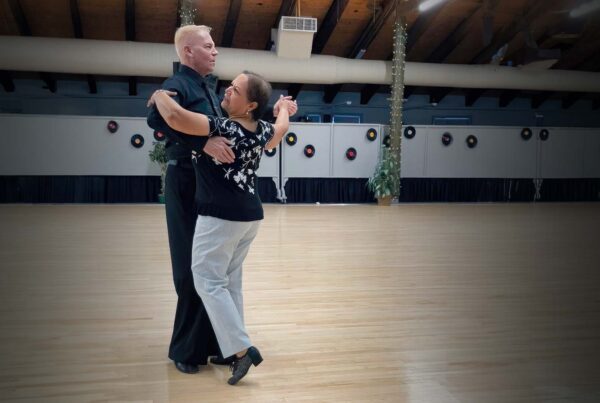Many dancers competing at the championship level, not to mention those who are still working their way there, really have no idea how important nutrition is to their success as an athlete. This article will help to shed light on some of the issues.
As body fat levels decline, a greater percentage of the body “mass” or weight is made up of muscle. This generally increases metabolism, or the body’s efficiency at converting food to energy. The formula gets complicated as you get older because of other issues, but muscle always increases BMR (Base Metabolic Rate). Athletes, therefore, need additional calories from all sources.
But there’s a common misunderstanding that because athletes burn so many calories, they can eat anything they like. This simply isn’t true. In fact, the more highly tuned you are as an athlete, the more sensitive your body becomes to the things that don’t help your performance. Foods that impede the efficiency of the body’s muscle burning “engine” become a burden. Now, the impact of fried chicken or too much chocolate have greater negative effects. Once in a while, this won’t hurt. A few consecutive days of eating the wrong things will leave you sluggish and lacking energy, with slower recovery after a hard practice session. The more you train, the more important nutrition becomes.
Your weekly training hours and intensity of training, as well as your goals for body composition will impact your dietary needs. Some nutritionists categorize weekly training volume to determine dietary energy requirements. For example, Kelly Anne Erdman, MS, RD and 1992 Cycling Olympian who is now a consulting dietician for the Canadian Sport Centre in Calgary, divides her clients into three categories: less than six hours per week, 6-12 hours per week, and more than 12 hours. These represent the hours they spend weekly in high-energy training. Even a triathlete can be in the middle category during the off season, and will move into the highest training category when preparing for events.
If you have specific goals like reducing body fat to make that six pack show, or increasing flexibility, or recovering from an injury, these goals might affect what you should eat. You may be wise to see a nutritionist to help plan your eating patterns. Other issues like reaction to milk, bread or cheese may need to be considered as you plan your normal eating habits. A Naturopathic doctor or sports nutritionist can conduct a complex test to discover allergies you may not be aware of to further optimize your body for performance.
Supplements like protein shakes may be a good idea. I like to consume a protein shake after each gym workout. It’s generally recommended to take in liquids high in protein within two hours of any high-intensity muscle workout, to help provide essential proteins to repair muscular cell damage. Chocolate milk is also very effective. But don’t buy into the myth that your entire diet needs to be high in protein. There’s a limit to how much protein the body can use, regardless of how hard you train. In fact, the latest research shows that carbohydrates (complex carbs, not simple carbs found in sugar) have as much if not more influence on muscle recovery. The older you get, it seems, the more important carbohydrates become.
Tracking your dietary progress
It also helps to track your dietary intake. You might feel this is too complicated, but think about it. Eating without tracking your caloric intake is like writing checks without knowing how much money is in your bank account.
Some people say we shouldn’t obsess over what we eat, but athletes need to track this just like you need to track your bank balance if you’re planning your retirement. There are a number of great mobile apps that make it easy to track your eating throughout the day. My personal favorites are MyFitnessPal and LoseIt! Both apps show you how many calories you’ve taken in during the day, and how many are left in your daily “budget.” They even make it easy to add foods by simply scanning the bar code on that grocery item you’re about to open. You can also see a breakdown of your metrics (like fat, carbohydrates and protein). It’s easy to add exercises (even dancing is included in the lists) but I’ve found that it’s better to undervalue the caloric burn of activities as it leads to more accurate results.
The program shows you your weekly tally, because you can choose to go crazy from time to time if you’ve been consistent in following your recommended nutritional plan. If your athletic or enjoy an active lifestyle, it’s healthy to let yourself enjoy the things you normally deny yourself, as long as it happens only occasionally. When we won major competitions, Wendy and I would treat ourselves to a big steak dinner at the Keg or somewhere comparable to celebrate and let our hair down on the rigid nutritional discipline we live by most days.
If you aren’t a competitive dancer, you can just stop there, focusing on your nutritional intake as a lifestyle. But if you’re an athlete or competitive dancer, you need to go further with your planning.
Besides the normal dietary patterns, you need to think about what you eat on the day of competition. Performances, whether Standard or Latin, are not only high intensity, but also stressful in other ways because of the mental energy involved. This affects the body in ways that normally wouldn’t be an issue. You need to be “on” in every sense of the word, so you must plan your competition-day eating to maximize your energy levels.
In an interview, one of the world’s top WDSF Ballroom championship couples, Simone Segatori and Annette Sudol, mentioned that on competition days they eat breakfast, but then minimize what they eat for the rest of the day. This is vital!
Wendy and I learned this the hard way. Once, with several hours to kill between afternoon rounds and finals at the end of the evening, we went out for a nice restaurant meal, thinking it would be long burned off and digested by the time we had to perform. It was a big mistake. Even hours later, we found it very hard to dance at our usual energy level, feeling heavy and sluggish. After that, we became very scientific in our dietary plan for competition days. We would eat an appropriate balanced breakfast, with Clif bars and Power bars the rest of the day until after the competition is over.
Competitive dancers are athletes in every sense of the word. They need to think like an athlete, plan their eating like an athlete, and train like an athlete. It’s how the world’s top dancers end up on the podium.
But regardless of your goals as a dancer, given the pandemic we are all dealing with, a huge number of normally highly active people have found their activity levels to be significantly reduced. Taking care of your nutritional intake will be a vital part of getting back into shape.













